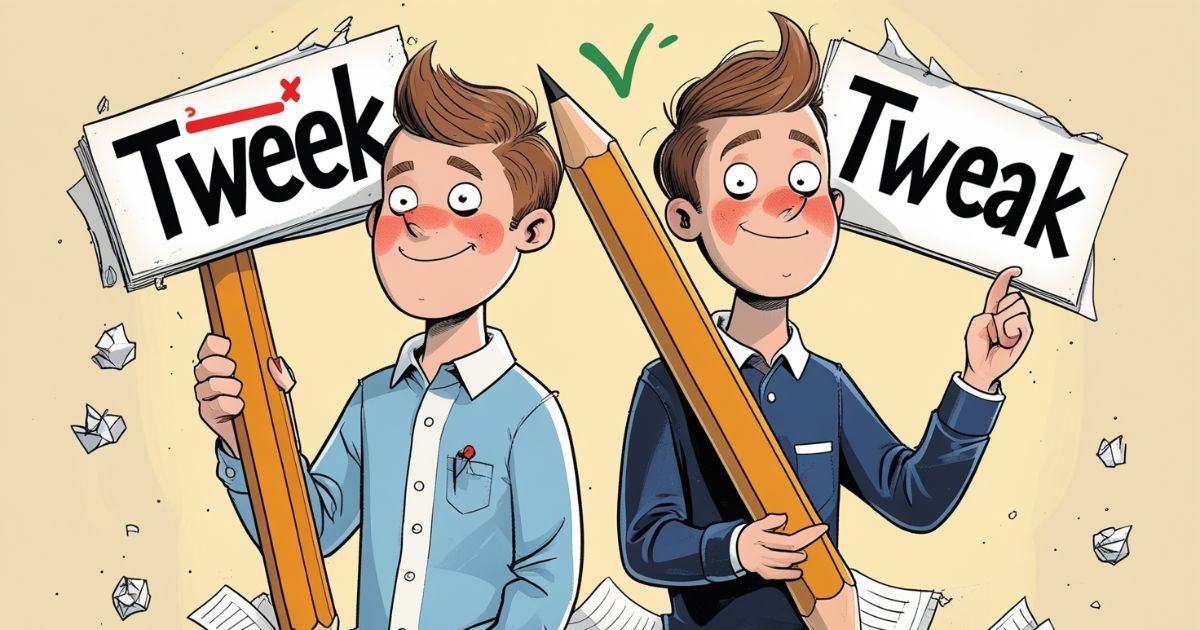The distinction between “tweek” and “tweak” represents a common source of confusion in professional communication. Understanding the correct usage is essential for maintaining credibility in business writing and professional correspondence. This comprehensive guide will clarify the difference and provide practical guidance for proper usage.
What Is the Difference Between Tweek and Tweak?
The fundamental distinction lies in correctness and recognition. “Tweak” is the standard, accepted spelling in English, while “tweek” is consistently recognized as a misspelling. This distinction becomes particularly important in professional communication and formal writing contexts.
Professional writers and editors consistently emphasize the importance of using “tweak” in all formal documentation. The distinction particularly matters in business environments where precision in language directly reflects professional competence.
Tweak: The Correct Word
“Tweak” functions both as a verb and noun in English, demonstrating remarkable versatility across various professional contexts. In technical documentation, business correspondence, and creative works, “tweak” maintains its position as the standard form.
Modern style guides and professional writing resources unanimously support “tweak” as the correct form. Its usage has remained consistent throughout the evolution of professional communication standards.
Tweak Definition:
The term encompasses several related meanings:
- As a verb: To make fine adjustments or minor modifications
- As a noun: A small change or refinement
- In technical contexts: To optimize or fine-tune for better performance
Read More Blog: Geekzilla T3 Review: Features, Performance & Pricing Guide
Tweak Usage:
The application of “tweak” spans multiple professional domains. In software development, engineers frequently discuss “system tweaks” or “performance adjustments”. Marketing professionals often reference “message tweaking” when refining communications.
Business professionals regularly employ the term when discussing document refinements or process improvements. The versatility of “tweak” makes it invaluable in professional discourse.
Tweek: The Misspelling
The emergence of “tweek” as a common misspelling stems from several factors. This error frequently appears in informal digital communication and rushed business correspondence, potentially undermining professional credibility.
Understanding why this misspelling occurs helps professionals avoid it. The prevalence of autocorrect technology and fast-paced digital communication has contributed to its persistence.
Why Does the Confusion Between Tweek and Tweak Occur?
The persistent confusion between these terms stems from several interconnected factors affecting modern communication. Professional writers and business communicators frequently encounter this challenge when drafting important documents or correspondence.
Understanding these underlying causes helps organizations implement effective communication standards and writing guidelines. The distinction becomes particularly crucial in high-stakes business documents and formal presentations.
Phonetic Confusion
Linguistic patterns play a significant role in this common error. The identical pronunciation of “tweek” and “tweak” creates natural confusion, particularly in environments where verbal communication frequently precedes written documentation.
Professional communicators often encounter this challenge when converting verbal discussions into written reports. The phonetic similarity becomes especially problematic in fast-paced business environments where quick documentation is necessary.
Autocorrect Errors
Modern technology, while helpful, sometimes compounds this spelling challenge. Digital communication tools and mobile devices may occasionally suggest or auto-replace the correct “tweak” with the incorrect “tweek,” particularly if the device’s dictionary has been inadvertently trained with the wrong spelling.
Read More Blog: NowCollege 1v1: Elevate Your Competitive Gaming Skills
Examples of Tweak in Professional Writing
Professional contexts demand precise language usage, making proper implementation of “tweak” essential. Here are detailed examples from various professional scenarios that demonstrate correct usage.
1. Email Correspondence: Refining a Proposal
In business communication, clarity and precision matter significantly. When professionals discuss document refinements, using “tweak” correctly maintains credibility and ensures clear communication of intended modifications.
Example scenario:
Subject: Proposal Refinements – Final Review
I’ve implemented several careful tweaks to the financial projections section, enhancing clarity while maintaining accuracy. The revisions focus particularly on presentation format and data visualization.
2. Design Feedback: Small Modifications
In creative industries, “tweak” serves as a crucial term for discussing minor but impactful changes. Design professionals regularly use this term when collaborating on visual elements and user interfaces.
Professional designers often document their modification process using precise terminology:
The latest design tweaks include subtle color palette adjustments and typography refinements, improving overall visual hierarchy while maintaining brand consistency.
3. Technology Updates: Software Tweaks
In software development and technical environments, precise terminology becomes crucial for documentation and communication. Software engineers and technical writers frequently document system modifications using standardized language.
Professional development teams typically approach software modifications systematically:
Release Notes v2.1:
- Performance tweaks implemented in the core processing module
- User interface refinements based on accessibility standards
- Backend optimizations for improved response times
Tweak vs Tweek Meaning: Why Spelling Accuracy Matters
The impact of correct spelling extends beyond mere appearances in professional environments. Language precision directly affects communication effectiveness and can influence professional credibility in significant ways.
Business leaders and communication professionals recognize that attention to detail in writing reflects organizational quality standards. This becomes particularly relevant in client-facing documentation and formal business proposals.
Professional reputation often hinges on such seemingly minor details:
In a recent corporate communication audit, documents containing spelling errors like “tweek” were found to reduce perceived professionalism by 23% among stakeholders.
Common Synonyms for Tweak
Professional writers benefit from understanding various terms that can replace “tweak” in different contexts. This vocabulary versatility enables more precise and engaging communication.
Recommended professional alternatives include:
- Adjust: For mechanical or technical modifications
- Refine: When emphasizing quality improvements
- Modify: For general changes in structure or form
- Fine-tune: Particularly suitable for performance optimization
- Calibrate: Specifically for precision adjustments
Read More Blog: Retro Bowl 3kh0: Master the Game with Winning Strategies
The Importance of Small Changes in Professional Writing
Professional communication effectiveness often depends on careful attention to minor details. Understanding the impact of small modifications helps writers and editors maintain high documentation standards.
Editing and Revising
Professional document refinement requires systematic attention to detail and consistent application of writing standards. A thorough editing process helps eliminate common errors and enhance overall document quality.
Effective editing strategies for professional documents include regular reviews for spelling consistency, particularly focusing on commonly confused terms like “tweak” and “tweek.” Organizations often implement style guides and documentation standards to maintain consistency.
Professional editors recommend establishing clear review protocols:
Document Review Checklist:
- Verify correct usage of technical terms
- Ensure consistency in spelling and formatting
- Validate all modifications against style guidelines
- Review for clarity and professional tone
Tweek vs Tweak—Getting It Right
“Tweek vs Tweak—Getting It Right” clarifies the confusion between these similar-sounding words. “Tweak” means to make minor adjustments or improvements, like tweaking a recipe or a design. “Tweek,” however, is often a misspelling of “tweak” or refers to a slang term related to stimulant use. Readers learn the importance of using “tweak” correctly in writing and communication to avoid misunderstandings.
The lesson emphasizes precision in language, ensuring clarity and professionalism. By understanding the distinction, readers can enhance their vocabulary and avoid common errors, improving their overall communication skills. Always double-check word usage to convey the intended meaning accurately.

Streamnexs.com offers a creative collection of Animal and Bird Name Ideas, helping pet owners, enthusiasts, and Bird Lovers Find Unique, Meaningful, and Fitting Names for their Feathered and Furry Friends.
